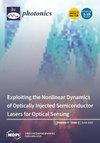脑深部组织光声成像的图像增强方法
IF 1.9
4区 物理与天体物理
Q2 OPTICS
引用次数: 0
摘要
光声成像(PAI)是一种新兴的生物医学成像模式,具有高分辨率和高对比度等诸多优点。然而,在应用于脑部成像时,由于头骨的扭曲效应,来自脑组织的光声(PA)信号会大大减弱。这种衰减大大降低了分辨率和对比度。为了解决这个问题,我们在这里介绍一种 Log-MSR 算法,它结合了对数深度对数增强(Log)算法和多尺度 Retinex(MSR)算法。在这种方法中,Log 算法根据不同深度的信号衰减进行局部加权补偿,而 MSR 算法则改善图像的对比度。所提出的对数-MSR 算法通过多个模型和活体实验进行了测试和验证。我们从大脑结构和功能的角度对使用对数-MSR 算法构建的增强图像进行了定性和定量分析。结果表明,Log-MSR 算法可显著增强深部脑组织的光声成像。本文章由计算机程序翻译,如有差异,请以英文原文为准。
Image Enhancement Method for Photoacoustic Imaging of Deep Brain Tissue
Photoacoustic imaging (PAI) is an emerging biomedical imaging modality, offering numerous advantages, including high resolution and high contrast. In its application to brain imaging, however, the photoacoustic (PA) signals from brain tissue weaken considerably due to the distortion effects of the skull. This attenuation reduces the resolution and contrast significantly. To address this issue, here we describe a Log-MSR algorithm that combines the logarithmic depth logarithmic enhancement (Log) algorithm and the multi-scale Retinex (MSR) algorithm. In this method, the Log algorithm performs local weighted compensation based on signal attenuation for different depths, while the MSR algorithm improves the contrast of the image. The proposed Log-MSR algorithm was tested and validated using several phantom and in vivo experiments. The enhanced images constructed by the Log-MSR algorithm were qualitatively and quantitatively analyzed in terms of brain structure and function. Our results show that the Log-MSR algorithm may provide a significant enhancement to photoacoustic imaging of deep brain tissue.
求助全文
通过发布文献求助,成功后即可免费获取论文全文。
去求助
来源期刊

Photonics
Physics and Astronomy-Instrumentation
CiteScore
2.60
自引率
20.80%
发文量
817
审稿时长
8 weeks
期刊介绍:
Photonics (ISSN 2304-6732) aims at a fast turn around time for peer-reviewing manuscripts and producing accepted articles. The online-only and open access nature of the journal will allow for a speedy and wide circulation of your research as well as review articles. We aim at establishing Photonics as a leading venue for publishing high impact fundamental research but also applications of optics and photonics. The journal particularly welcomes both theoretical (simulation) and experimental research. Our aim is to encourage scientists to publish their experimental and theoretical results in as much detail as possible. There is no restriction on the length of the papers. The full experimental details must be provided so that the results can be reproduced. Electronic files and software regarding the full details of the calculation and experimental procedure, if unable to be published in a normal way, can be deposited as supplementary material.
 求助内容:
求助内容: 应助结果提醒方式:
应助结果提醒方式:


